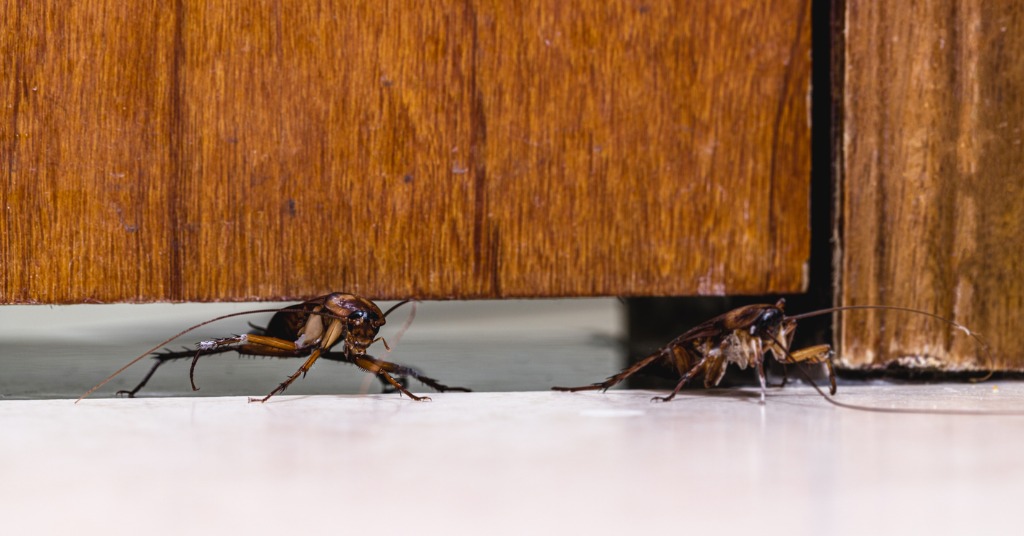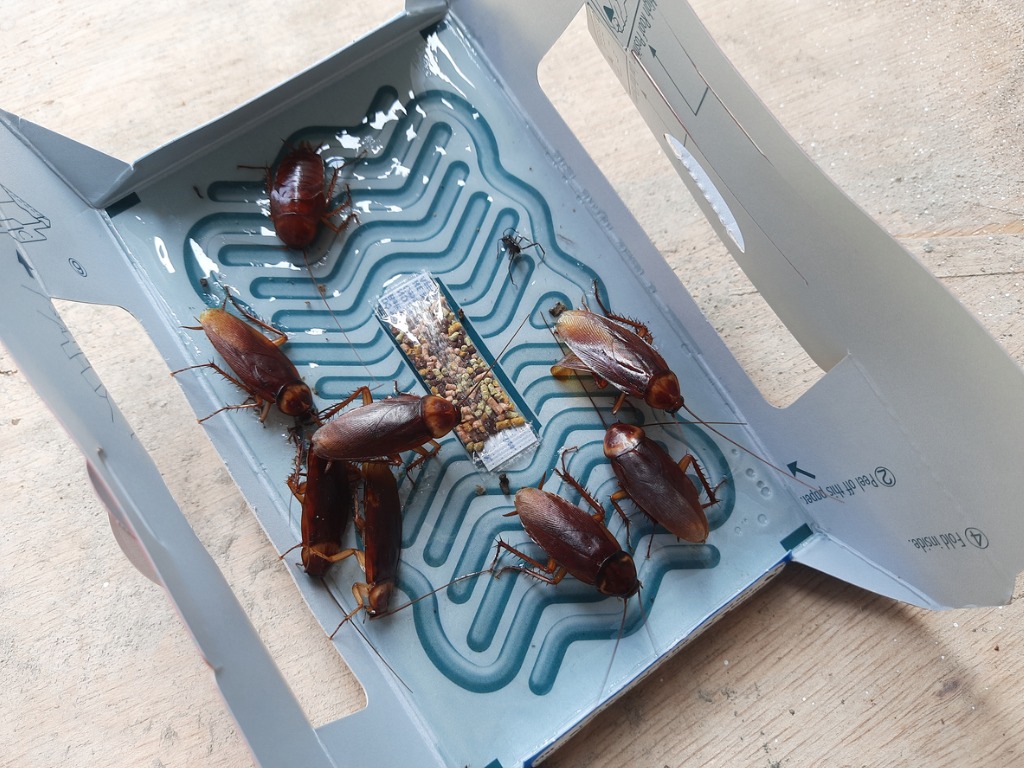Cockroaches, the very mention of which can send shivers down one’s spine, are not just a mere nuisance; they are carriers of various diseases and can cause significant health concerns when they invade our homes. These hardy pests have mastered the art of survival, thriving in various environments, and often evading our best efforts to eradicate them. Understanding their behavior, preferred habitats, and breeding patterns is crucial to combatting an infestation effectively. In this guide, we’ll arm you with the knowledge you need to identify signs of a cockroach infestation and provide practical steps to tackle and prevent these unwelcome intruders in your home.
Key takeaways
- Identify cockroach infestations through sightings, droppings, odor, egg cases, and shed skin.
- Prevent infestations by maintaining cleanliness, sealing entry points, and eliminating moisture sources.
- Understand common cockroach species, behavior, and habits for effective control.
- Utilize DIY methods like traps, baits, and home remedies such as boric acid.
- Seek professional pest control when DIY efforts fail or for severe infestations.
- Quick eradication is crucial to prevent health risks and further infestations.
How can I identify the presence of cockroaches in my home?
- Sightings: The most obvious sign is actually seeing cockroaches in your home. Cockroaches are nocturnal, so they are most active at night. If you see them scurrying around in your kitchen, bathroom, or other areas, it’s a clear indicator.
- Droppings: Cockroach droppings look like small, dark, and cylindrical pellets. These fecal droppings are often found in places where cockroaches hide and travel, such as in cabinets, drawers, or along baseboards.
- Odor: Cockroaches emit a strong, musty odor that becomes more noticeable as their population increases. If you notice an unpleasant, lingering smell in your home, it could be a sign of a cockroach infestation.
- Egg Cases (Oothecae): Cockroach egg cases are brown, oval-shaped, and typically found in hidden sheltered areas. These egg cases can hold multiple cockroach eggs and are a clear sign that roaches are breeding in your home.
- Shed Skin: Cockroaches shed their exoskeletons as they grow. You might find these translucent, empty shells in areas where cockroaches are active.
How can I prevent cockroach infestations in the first place?
To prevent cockroach infestations, maintain a clean home by regularly cleaning up crumbs and spills, storing food in airtight containers, and eliminating clutter. Seal cracks and entry points, fix moisture issues, and use screens on doors and windows. Inspect incoming items for signs of cockroaches, maintain outdoor areas, and consider professional pest control for regular inspections. Being proactive and practicing good hygiene are key to keeping cockroaches at bay.
Understanding Cockroaches
- Common Species of Cockroaches: Several common species of cockroaches can infest homes. These include the German Cockroach (small, light brown), American Cockroach (large, reddish-brown), Oriental Cockroach (shiny black or dark brown), and Brown-banded Cockroach (small with light bands on its body).
- Cockroach Behavior and Habits: Cockroaches are primarily nocturnal, preferring to stay hidden during the day. They are omnivorous, feeding on various foods and non-food items. Cockroaches reproduce rapidly, with females capable of producing many offspring. They have impressive survival skills, enduring periods without food and water and even surviving briefly without their heads.
- Signs of a Cockroach Infestation: Detecting a cockroach infestation involves noticing certain indicators, such as small, dark droppings resembling coffee grounds, a distinct musty odor in infested areas, discarded exoskeletons from growing roaches, the presence of live roaches (especially at night), brown, oval-shaped egg cases (oothecae) in hidden areas, dark, greasy smudges along walls and surfaces where they move, and damage to items like books and fabric caused by roaches gnawing on them.
Identifying Cockroach Infestations

1. Visual inspection
To begin identifying a cockroach infestation, conduct a thorough visual inspection of your home. Start in areas where cockroaches are commonly found, such as the kitchen, bathroom, and basement. Look for live cockroaches scurrying about, their egg cases known as oothecae, shed skin, and distinctive droppings. Cockroach droppings resemble small, dark particles similar to coffee grounds or pepper flakes. Additionally, be attentive to any unusual or musty odors, as cockroaches can emit a foul smell.
2. Common hiding spots
Cockroaches are adept at hiding in concealed areas, and knowing where to look is essential. They prefer environments that are dark, warm, and moist. Check behind and under appliances like refrigerators, stoves, and dishwashers, as these are common hiding spots. Inspect cracks and crevices along baseboards, cabinets, and walls, where cockroaches often seek refuge. Bathrooms are also prime locations, especially behind toilets and under sinks. Don’t overlook cardboard boxes, stored papers, or clutter, as cockroaches can lurk there as well.
3. Signs of cockroach activity
Identifying cockroach activity goes beyond merely spotting the insects themselves. Look for telltale signs such as fecal matter, which resembles small, dark droppings or smears. Egg cases, small brown or reddish-brown capsules, can often be found in hidden areas. Keep an eye out for marks or stains left behind by cockroaches on surfaces they traverse. They may also cause damage by chewing on food packaging, cardboard, and even electrical wires. Additionally, some species of cockroaches may produce a rustling or chirping sound.
4. Using traps and baits
To confirm the presence of cockroaches and reduce their population, consider using traps and baits. Cockroach traps can be strategically placed in areas where you suspect cockroach activity. These traps are designed to capture cockroaches when they enter or exit. Cockroach baits, on the other hand, contain insecticide and are attractive to cockroaches. Once consumed, the insects carry the poison back to their nests, helping to control the infestation.
5. Calling in a professional pest inspector
When in doubt or when dealing with a severe infestation, it’s advisable to seek professional assistance. Pest control companies employ trained inspectors who possess the expertise and tools necessary to accurately assess the infestation. They can identify the specific cockroach species involved and implement effective treatments. These treatments may include the use of insecticides, insect growth regulators, or other methods to eliminate the infestation and prevent future outbreaks. Engaging a professional ensures a comprehensive and lasting solution to your cockroach problem.
Prevention Measures
Maintaining cleanliness and hygiene
One of the most effective ways to prevent cockroach infestations is by maintaining cleanliness and good hygiene practices in your home. Regularly clean and sanitize your living spaces, especially the kitchen and bathroom, as these are prime areas for cockroach activity. Sweep, mop, and vacuum floors, and wipe down countertops and appliances to remove food residue. Dispose of garbage promptly in sealed containers and clean up spills immediately.
Proper food storage
To prevent cockroaches from accessing their primary food source, it’s crucial to store food properly. Use airtight containers to store dry goods like cereals, grains, and pet food. Avoid leaving food out on countertops overnight. Dirty dishes should be washed promptly, and pet food should not be left out for extended periods. Cockroaches can survive on even tiny crumbs, so keeping your kitchen and pantry free of food debris is essential.
Sealing entry points
Cockroaches can enter your home through tiny cracks and openings, so it’s important to seal entry points. Inspect your home for gaps in doors, windows, and walls, and use caulk or weatherstripping to seal them. Pay close attention to areas where pipes and utility lines enter your home, as these are common entry points. Repair any damaged screens on doors and windows to prevent cockroaches from entering.
Eliminating moisture sources
Cockroaches require moisture to survive, so eliminating moisture sources is key to prevention. Fix any plumbing leaks promptly, as even minor drips can provide sufficient moisture for cockroaches. Ensure proper ventilation in areas prone to humidity, such as bathrooms and basements. Use dehumidifiers if necessary to reduce excess moisture. Additionally, regularly clean and dry areas where water tends to accumulate, like sinks, tubs, and shower stalls.
DIY Cockroach Control

Home Remedies
Utilize safe and natural home remedies, such as boric acid, which can be sprinkled in cockroach-prone areas to dehydrate and kill them. You can also use essential oils like peppermint or eucalyptus, diluted in water and sprayed in infested areas. Catnip, a natural cockroach repellent, can be placed in sachets or sprinkled in problem areas. Homemade traps, like jars with bait (e.g., coffee grounds or bread), can be effective in capturing them.
Commercial Insecticides
When dealing with a more significant infestation, consider using commercial insecticides labeled for cockroach control. These products are specifically formulated to target cockroaches. Always read and follow the manufacturer’s instructions carefully. Wear protective gear like gloves and a mask, and apply the insecticide in cracks, crevices, and hiding spots where cockroaches are active. Reapply as needed based on the product’s guidelines.
Traps and Baits
Cockroach traps and bait stations can be highly effective. Sticky traps placed in areas of cockroach activity can capture them as they move around. Bait stations attract cockroaches to poison, which they carry back to their nest, affecting the entire population. Be patient, as baits may take time to work, and avoid disturbing them.
Protective Measures
Prioritize safety during treatment to protect your family and pets. Remove food, dishes, and utensils from areas being treated. Store food and pet supplies in airtight containers. Seal trash cans securely to prevent cockroach access. After treatment, wash countertops, dishes, and cooking utensils thoroughly. Keep children and pets away from treated areas until it’s safe to re-enter. Additionally, maintain good hygiene practices, including regular cleaning and proper food storage, to prevent future infestations.
Professional Cockroach Extermination
When to hire a pest control expert
You should consider hiring a pest control expert for cockroach problems when DIY efforts fail to resolve a severe or persistent infestation. Health concerns like allergies or disease transmission from cockroaches are a clear signal for professional help. If repeated infestations persist or you’re a property manager dealing with rental units, professionals can ensure complete eradication. Unique or challenging situations, such as commercial kitchens or sensitive environments, also necessitate professional expertise.
What to expect during a professional treatment
When professionals handle cockroach extermination, expect a structured process. It begins with a thorough inspection to assess the infestation’s extent and locate hiding spots. A customized treatment plan is created, potentially involving insecticides, baits, traps, or growth regulators. Safety is paramount, and temporary vacating of treated areas may be required. Follow-up visits and prevention recommendations are common to ensure ongoing control.
Follow-up and maintenance
After professional treatment, diligent follow-up and maintenance are vital. Monitor cockroach activity to verify its decline post-treatment. Adhere to recommended follow-up treatments as needed. Preventive measures like sealing entry points, maintaining hygiene, and proper food storage should be practiced to deter future infestations. Regular professional inspections, especially in high-risk settings, help catch potential issues early, maintaining a cockroach-free environment and ensuring long-term effectiveness.
Cockroach-Related Health Risks
Diseases and allergies associated with cockroaches
Cockroaches are carriers of diseases such as salmonella and E. coli, posing a risk of food contamination and gastrointestinal illnesses. Additionally, their droppings, saliva, and skin contain allergenic proteins that can trigger allergic reactions and worsen asthma symptoms, particularly in children and those with respiratory conditions.
The importance of quick eradication
Swiftly eradicating cockroach infestations is essential to reduce the risk of disease transmission and allergies. Quick action minimizes food contamination, prevents health issues, and stops the infestation from spreading, saving both time and money in the long term.
Dealing with Specific Cockroach Species
German cockroaches
Recognize them by their small size, light brown to tan color, and two dark stripes. Control with cleanliness, baits, and traps, and consider professional help for severe infestations.
American cockroaches
Identify their larger size, reddish-brown color, and potential indoor presence. Control by reducing outdoor harborages, using traps, managing moisture, and consulting professionals for indoor infestations.
Oriental cockroaches
Identify them by their dark, shiny appearance. Control by addressing moisture issues, maintaining cleanliness, applying barrier treatments, and seeking professional help for severe infestations.
Common Mistakes to Avoid
Misidentification of pests
One of the most significant mistakes is misidentifying the pests you’re dealing with. Different pests require different control methods. Misidentification can lead to ineffective treatments and wasting time and resources. To avoid this error, take the time to correctly identify the pest or consult a professional if you’re unsure. Accurate identification is the first step toward effective pest control.
Ineffective treatments
Using ineffective or outdated treatments is another common mistake. Pest control products and methods evolve, and pests can develop resistance over time. Using the wrong treatment or failing to follow recommended guidelines can allow infestations to persist or worsen. Always read and follow product labels carefully, and consider consulting with pest control professionals who have access to the latest and most effective treatments.
Neglecting prevention
Neglecting preventive measures is a mistake that can lead to recurring pest problems. Prevention is often more cost-effective and less time-consuming than dealing with an established infestation. Simple steps, such as sealing entry points, maintaining cleanliness, and practicing proper food storage, can go a long way in deterring pests. Don’t wait for a pest problem to arise before taking preventive actions. Regularly assess and address potential pest entry points and conditions that attract them to your home or property.
Conclusion
Identifying and tackling cockroach infestations in your home is crucial for the health and safety of you and your family. By being proactive and familiarizing yourself with the signs of an infestation, you can take immediate action to eliminate these pests. Regular cleaning and maintenance, sealing entry points, and using effective pest control products are essential steps in preventing cockroach problems. Remember to consult with a professional if the infestation persists or becomes overwhelming. Don’t let cockroaches take over your home – take control today and create a clean and healthy living environment for you and your loved ones.
FAQ 1: What are the most common signs of a cockroach infestation?
The most common signs of a cockroach infestation include the presence of small, dark cockroach droppings resembling coffee grounds, a musty odor, the discovery of discarded cockroach egg cases (oothecae), and frequent sightings of live cockroaches, particularly in kitchen and bathroom areas, especially during nighttime when they are most active. Identifying these signs is crucial for early intervention and effective pest control.
FAQ 2: Are cockroaches harmful to my health?
Yes, cockroaches can be harmful to your health as they are known carriers of disease-causing bacteria, allergens, and pathogens. Their presence in the home can trigger allergies, asthma, and other respiratory issues, making them a potential threat to your well-being.
FAQ 3: What are some natural remedies to get rid of cockroaches?
Natural remedies to get rid of cockroaches include using boric acid or diatomaceous earth, placing cucumber peels or bay leaves in infested areas, and maintaining a clean and dry environment to deter their presence.
FAQ 4: Are there any health risks associated with DIY cockroach control methods?
Yes, there are potential health risks associated with DIY cockroach control methods. Some chemicals and substances used, like boric acid or pesticides, can be toxic if mishandled or ingested. Inhaling dust from these substances or coming into direct contact with them can also pose health risks, so it’s essential to follow safety guidelines and consider professional pest control if unsure.
FAQ 5: How often should I schedule professional pest inspections to prevent future infestations?
Scheduling professional pest inspections for preventive measures typically depends on factors such as your location, the severity of past infestations, and the type of pests in your area. As a general guideline, an annual inspection is a good starting point, but you may need more frequent inspections in high-risk areas or if you’ve had previous pest issues. Consulting with a local pest control expert can help determine the appropriate frequency for your specific situation.

